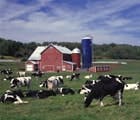A recent report in the New York Times details the extent of agricultural runoff pollution in a Wisconsin community.
The 41,000 dairy cows in Brown County produce more than 260 million gal of manure per year. Much of the manure is spread on grain fields as fertilizer. Excessive amounts can result in bacteria and chemicals contaminating tap water, however.
Within a few months, more than 100 wells in the community of Morrison were contaminated by agricultural runoff. Residents began suffering from chronic diarrhea, stomach problems and ear infections, the newspaper reported.
“Sometimes it smells like a barn coming out of the faucet,” said Lisa Barnard, who lives 15 miles from Green Bay.
The federal laws that are meant to protect drinking water and prevent pollution leave runoff essentially unregulated in all but the biggest farms, according to the report. The Clean Water Act of 1972 does not typically apply to waste that is sprayed on a field (and then seeps into groundwater) because it mainly regulates chemicals or contaminants that move through pipes or ditches. Many agricultural pollutants are only subject to state or county regulations.
In an effort to address the problem, the U.S. Environmental Protection Agency (EPA) has created special rules for the largest farms—those with at least 700 cows.
The EPA wrote in a statement that officials are working with federal agencies including the Agriculture Department to bring large farms into compliance.
According to the EPA, agricultural runoff is the single largest source of water pollution in the nation’s rivers and streams. Approximately 19.5 million Americans get sick from waterborne parasites like viruses or bacteria, including those stemming from human and animal waste, each year, according to a study published in 2008 in Reviews of Environmental Contamination and Toxicology.
Other states are facing similar problems. In California, up to 15% of wells in agricultural areas may exceed the federal contaminant threshold. Government reports show that major waterways like the Chesapeake Bay have been seriously impaired by agricultural pollution.
Chicken farm owners in Maryland and Arkansas have been accused of polluting drinking water. In 2005, Oklahoma’s attorney general sued 13 poultry companies for alleged damages to an important watershed.
“One cow produces as much waste as 18 people,” said Bill Hafs, a Brown County official who has lobbied the state legislature for stricter waste rules. “There just isn’t enough land to absorb that much manure, but we don’t have laws to force people to stop.”
An early thaw in Brown County in 2006 melted frozen fields, some of which were covered in manure. A county study reported that within days, more than 100 wells were contaminated with coliform bacteria, E. coli or nitrates.
Some residents only realized their water might be contaminated when their neighbors began getting sick, prompting them to test their own water.
“More than 30% of the wells in one town alone violated basic health standards,” Hafs, the Brown County regulator responsible for land and water conservation, told the newspaper. “It’s obvious we’ve got a problem.”
Dairy owners claim it is unfair to blame them for the county’s water problems, noting that state regulators were unable to definitively establish the source of the 2006 contamination in their reports.
Many environmental advocates argue that stricter federal laws are the only way to reduce agricultural pollution. Lisa P. Jackson, the EPA administrator, recently ordered an increase in enforcement of the Clean Water Act. Tom Vilsack, the agriculture secretary, said that clean water is a priority and President Obama promised in campaign speeches to regulate water pollution from livestock.
Source: New York Times


